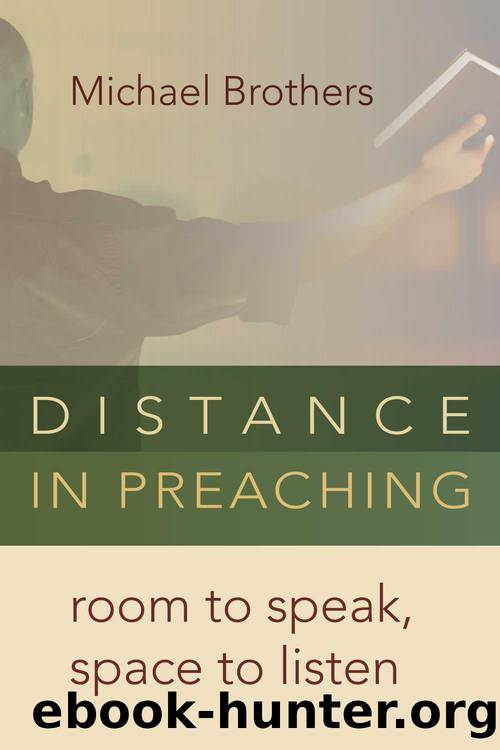Distance in Preaching by Brothers Michael;

Author:Brothers, Michael;
Language: eng
Format: epub
Publisher: Eerdmans
Published: 2014-07-25T00:00:00+00:00
The Bible as Realistic Narrative
In his preface to Preparation and Manifestation: Sermons for Lent and Easter, Ellingsen declares that the basic supposition of the biblical narrative approach is that we should read the Bible neither as the sourcebook for history of the early church, nor as a symbolic expression of religious experience. Instead, the Bible should be read in the same way we read a âpiece of great literature.â Ellingsen proposes that, if the Bible is to be read as literature, it then follows that the best tools for its interpretation and criticism are those of âliterary analysis,â for they provide the âmost appropriate approachâ to interpreting and preaching on biblical texts.9
The particular tools of literary analysis that Ellingsen deems most appropriate for biblical interpretation are those from what he terms âearly Anglo-ÂAmerican New Criticism.â A movement that began in America and England in the 1930s, New Criticism focused on a work of art as an âobject in itself,â or in the case of literature, âthe text alone.â According to the New Critics, a work of literature cannot be analyzed or interpreted according to the languages of science, the social sciences, history, or philosophy, for the object has its own language of meaning as âthe thing in itself.â The New Critics reacted against the mechanistic and positivistic nature of the modern world that reduced meaning to facts, propositions, and systems. They also protested against the Romantic notion that a work of art should be interpreted as a form of self-Âexpression. The early New Critics argued that art should be viewed âobjectivelyâ â that is, according to its own language of meaning.10
With regard to literary texts, the New Critics exposed the âintentional fallacyâ and the âaffective fallacyâ in methods of interpretation. They perceived the âintentional fallacyâ to be the erroneous interpretation of a text according to the intentions of its author. Ellingsen draws parallels between the quest for authorial intent in literary criticism and the source/historical method in biblical criticism, with its attempt to get âbehind the textâ to the âoriginal meaningsâ according to an author, redactor, or historical context.11
Not only did early New Criticism call into question meaning as found in authorial intent; it also rejected meaning in the textâs reception. New Critics exposed the âaffective fallacyâ as the mistaken attempt to locate the meaning of a text according to its âaffectâ on the contemporary reader (what would later be labeled âreader-Âresponseâ criticism). Ellingsen identifies the affective fallacy in contemporary homiletics as the aestheticism of narrative or story preaching. According to Ellingsen, this movement of the last two decades has focused on the experience and feelings of the hearer through its use of âlife stories.â Using Richard Lischerâs essay âThe Limits of Storyâ in support of his argument, he criticizes contemporary narrative preaching for serving the ânarcissism of our dayâ by turning the hearer away from others and inward toward the self.12
According to the New Critics, both âintentionalâ and âaffectiveâ approaches of interpretation overshadowed the meaning of the text according to the âtext itself.
Download
This site does not store any files on its server. We only index and link to content provided by other sites. Please contact the content providers to delete copyright contents if any and email us, we'll remove relevant links or contents immediately.
Cecilia; Or, Memoirs of an Heiress — Volume 1 by Fanny Burney(32318)
Cecilia; Or, Memoirs of an Heiress — Volume 3 by Fanny Burney(31697)
Cecilia; Or, Memoirs of an Heiress — Volume 2 by Fanny Burney(31673)
The Lost Art of Listening by Michael P. Nichols(7330)
Asking the Right Questions: A Guide to Critical Thinking by M. Neil Browne & Stuart M. Keeley(5544)
We Need to Talk by Celeste Headlee(5475)
On Writing A Memoir of the Craft by Stephen King(4797)
Dialogue by Robert McKee(4256)
Pre-Suasion: A Revolutionary Way to Influence and Persuade by Robert Cialdini(4068)
I Have Something to Say: Mastering the Art of Public Speaking in an Age of Disconnection by John Bowe(3805)
Elements of Style 2017 by Richard De A'Morelli(3268)
The Book of Human Emotions by Tiffany Watt Smith(3184)
Fluent Forever: How to Learn Any Language Fast and Never Forget It by Gabriel Wyner(2963)
Name Book, The: Over 10,000 Names--Their Meanings, Origins, and Spiritual Significance by Astoria Dorothy(2899)
Good Humor, Bad Taste: A Sociology of the Joke by Kuipers Giselinde(2845)
Why I Write by George Orwell(2840)
The Grammaring Guide to English Grammar with Exercises by Péter Simon(2668)
The Art Of Deception by Kevin Mitnick(2651)
Ancient Worlds by Michael Scott(2560)
